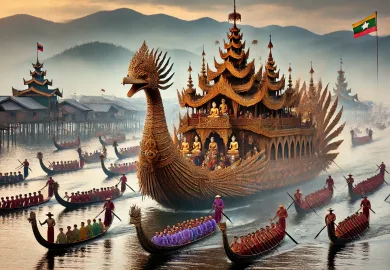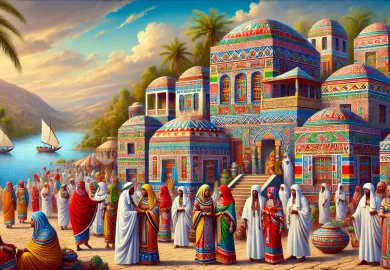
The Maasai people of Kenya are renowned for their vibrant beadwork, which not only serves as a form of adornment but also carries deep cultural significance. Beadwork has been an integral part of Maasai culture for centuries, with its colorful patterns and intricate designs symbolizing everything from social status to rites of passage. The Maasai community has preserved this art form, passing down the skills from generation to generation, making it a living testament to their cultural heritage. This article delves into the significance, history, and craftsmanship of traditional Maasai beadwork, a cultural treasure of Kenya.
The Symbolism Behind Maasai Beadwork
Maasai beadwork is not just about creating beautiful designs; it is deeply symbolic, with every color and pattern holding meaning. The beads are often used to communicate social and marital status, age group, and even clan affiliation within the community.

One of the most notable aspects of Maasai beadwork is its use in identifying different life stages. For instance, young Maasai women wear beads with specific patterns to signal their transition from childhood to adulthood. Similarly, warriors, known as moran, adorn themselves with specific bead designs that represent their bravery and accomplishments.
Colors play a crucial role in Maasai beadwork. Red, for instance, symbolizes bravery, strength, and unity. White stands for purity and health, while blue represents the sky and water, essential elements for the Maasai, who are pastoralists. Each piece of beadwork, therefore, tells a story, with its wearer expressing their identity and status within the community.
The History of Maasai Beadwork: A Tradition Through the Ages
The origins of Maasai beadwork can be traced back centuries. Before the arrival of Europeans and the introduction of glass beads, the Maasai used natural materials such as seeds, bones, and stones for their adornments. It was in the late 19th century, during the colonial period, that glass beads were introduced to the Maasai by traders from Europe and India. These colorful beads quickly became an essential element in Maasai adornment, replacing the traditional materials.
Despite the influence of modern materials, the Maasai people have retained the symbolic meanings associated with beadwork. The patterns and designs used today closely resemble those from the past, and the traditional significance of each piece has been carefully preserved. The beadwork has become a recognizable aspect of Maasai identity, making it a unique and powerful symbol of their culture.
The continued practice of beadwork within the Maasai community speaks to their resilience in preserving their traditions. Even as modern influences have spread throughout Kenya, the Maasai have maintained their beadwork as an essential part of their cultural expression.
The Craftsmanship Behind Maasai Beadwork: A Labor of Love
Creating Maasai beadwork requires patience, skill, and dedication. This intricate art form is typically passed down through generations, with Maasai women taking on the role of artisans. Learning how to make beadwork begins at a young age, and by the time a Maasai girl reaches adolescence, she is usually proficient in crafting complex designs.
The process begins with the selection of beads, which come in various colors and sizes. Maasai women meticulously choose beads based on the message they wish to convey through their designs. Once the beads are selected, they are carefully threaded onto wire, string, or leather strips to create necklaces, bracelets, earrings, and belts.
One of the most popular pieces of Maasai beadwork is the enkarewa, a large, elaborate necklace worn by women. These necklaces are typically worn during ceremonies such as weddings and initiation rites. Each necklace can take days or even weeks to complete, depending on its complexity. The artisans devote significant attention to detail, ensuring that every bead is perfectly placed to create a balanced and harmonious design.
The Role of Maasai Beadwork in Modern Kenya
While beadwork has always been an essential part of Maasai life, it has also found a place in the broader Kenyan culture. Many Maasai artisans have turned their craft into a source of income by selling beadwork to tourists and at local markets. These pieces, often inspired by traditional designs, have gained popularity both within and outside Kenya.
The commercialization of Maasai beadwork has not only brought economic benefits to the Maasai community but has also raised awareness of their cultural heritage on a global scale. However, there is a delicate balance between preserving the authenticity of Maasai beadwork and adapting it for the market. Some Maasai artisans create modern interpretations of traditional designs to appeal to a broader audience while maintaining the cultural significance of their work.
In addition, Maasai beadwork has become a symbol of Kenyan identity. It is not uncommon to see politicians, celebrities, and other public figures wearing Maasai-inspired jewelry as a way of celebrating their heritage and promoting Kenyan culture. As such, Maasai beadwork has evolved beyond its traditional context, becoming a national symbol of pride and cultural expression.
Preserving Maasai Beadwork for Future Generations
The preservation of Maasai beadwork is crucial for maintaining the cultural heritage of the Maasai people. With the rapid modernization of Kenya and the influences of globalization, there is a risk that traditional practices such as beadwork could fade away. However, the Maasai community has taken steps to ensure that this does not happen.
Cultural education programs have been established within Maasai communities to teach young people the art of beadwork and the meanings behind the designs. These programs aim to keep the tradition alive by passing on the skills and knowledge necessary for beadwork to the next generation. Moreover, cultural festivals and exhibitions showcase Maasai beadwork, providing a platform for Maasai artisans to display their work and share their heritage with a broader audience.
Collaborations between Maasai artisans and fashion designers have also helped to promote the art of beadwork. By incorporating Maasai beadwork into modern fashion, designers help bring attention to this ancient art form while providing economic opportunities for the artisans. This partnership between tradition and modernity ensures that Maasai beadwork remains relevant in today’s world without losing its cultural significance.
In conclusion, traditional Maasai beadwork is more than just decorative art; it is a powerful expression of Maasai identity, culture, and history. From its symbolic meanings to its intricate craftsmanship, beadwork continues to play an essential role in Maasai society and Kenyan culture as a whole. By preserving and celebrating this unique art form, the Maasai people ensure that their cultural legacy lives on for future generations.








